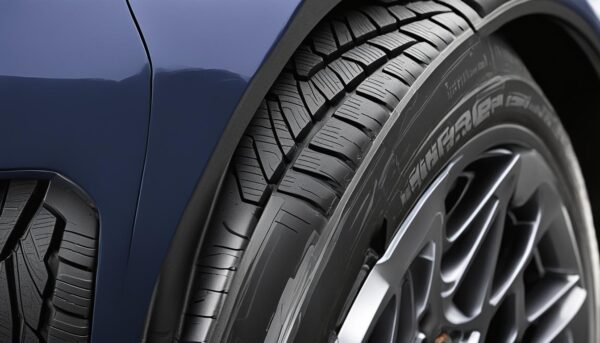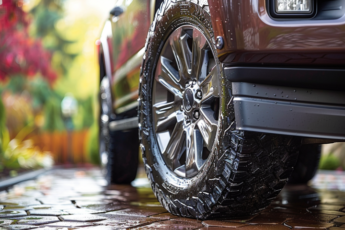Last Updated on 2 weeks
Understanding and Preventing Tire Flat Spotting During Extended Parking
Flat spotting can occur when your vehicle is parked for extended periods, especially during colder temperatures, causing your tires to flatten where they touch the ground. This can result in a bumpy and uneven ride due to the stiffening of the rubber. Regular movement and maintenance of your vehicle are required to prevent flat spotting and maintain tire health. Ignoring these precautions can lead to the premature deterioration of your tires, ultimately impacting your safety on the road.
Key Takeaways
- Flat spotting can cause tires to flatten in certain spots, leading to an uneven ride and potential tire damage.
- Extended parking and cold temperatures can increase the risk of flat spotting.
- Regular movement and maintenance, including proper inflation, prevent flat spotting and ensure tire health.
- Tire supports and jack stands can help protect tires from deformation during long-term parking or storage.
- High-performance tires are more susceptible to flat spotting due to their softer rubber compounds.
- Tire rotation and regular maintenance can prevent flat spotting, extend tire life, and ensure a safer driving experience.
Understanding Flat Spotting: Causes and Consequences
Flat spotting is primarily caused by the inherent characteristics of tire rubber compounds and prolonged parking, especially in colder climates where the rubber tends to stiffen. When a car remains parked for an extended period, the tires may develop flat spots, leading to thumping or bumping sensations while driving. Gaining a deeper understanding of the science behind flat spotting is crucial for its prevention, such as maintaining proper tire inflation and utilizing tire supports to preserve tire shape and functionality.
Several factors contribute to the development of flat spots, which can be categorized into the following:
- Long-term parking, particularly in cold weather
- Heavy vehicle load
- Improper tire inflation
- Softer rubber compounds found in high-performance tires
Tire safety should always be a priority, and understanding the causes of flat spotting is crucial to avoid the Damocles sword of potential tire damage.
The consequences of flat spotting can range from temporary inconveniences to more severe safety risks:
- Temporary flat spots – After driving the car for a few miles, tire pressure and temperature increase, the tires become more flexible, and, in most cases, the flat spots disappear.
- Permanent flat spots – Prolonged periods of inactivity and extreme weather conditions can cause irreversible deformation, affecting tire performance and compromising road safety.
Understanding these causes and consequences is essential to implement effective prevention methods. Neglecting these vital factors can result in costly tire damage and, more importantly, jeopardize the vehicle’s and its occupants’ safety.
Take a closer look at some of the most common consequences of flat spotting in the table below:
| Consequence | Description | Impact on Vehicle |
|---|---|---|
| Temporary Flat Spots | Uneven tire wear and flat spots caused by brief periods of inactivity; reversible with regular driving. | Reduced ride comfort may cause increased road noise and vibration. |
| Permanent Flat Spots | Irreversible deformation caused by extended periods of inactivity or extreme temperatures. | Significant impact on ride comfort, vehicle handling, and safety necessitates tire replacement. |
| Reduced Tire Longevity | Premature tire wear due to uneven pressure distribution and continuous deformation. | Increase in overall tire-related expenses; the need for more frequent tire replacements. |
Tire safety remains a pertinent issue on the road, and preventing flat spotting should be a priority for all drivers. By being vigilant and proactive in tire care, you can avoid the negative consequences of flat finding and ensure a safer and smoother driving experience.
The Warning Signs: Identifying Flat Spots on Your Tires
Recognizing the early signs of flat spotting is essential for maintaining tire safety and ensuring a smooth driving experience. By staying vigilant and conducting regular tire inspections, car owners can identify flat spots before they develop into costly and dangerous issues. There are several telltale signs that your tires may have flat spots:
- Rhythmic Thumping Sounds while Driving
- Vibrations in the Steering Wheel
- Disturbances in Vehicle Stability
Rhythmic thumping sounds are often the first identifiers that flat spots have formed on your tires. These noises stem from the irregular contact between the flattened tire surfaces and the road, affecting the overall harmony of your automobile’s motion.
Vibrations in the steering wheel signal that your tires may not be in the best condition. Flat spots can cause imbalanced rolling resistance and difficulty maneuvering, leading to tremors felt through the steering wheel. This can not only diminish driving comfort but also pose a safety hazard.
Disturbances in vehicle stability indicate that the tires’ contact with the ground may be compromised due to flat spots. Maintaining proper tire inflation and closely monitoring the tires for any visible deformations will help you address this issue before it escalates.
Regular tire inspections play a vital role in identifying flat spots early and ensuring a safer, smoother ride for drivers and passengers alike.
An effective tire maintenance routine is crucial for addressing problems like flat spots. Regular tire rotations, proper inflation, and strategic parking can all contribute to preserving the health and safety of your tires. Prioritizing tire inspection as part of your daily vehicle upkeep will help prevent the formation of permanent flat spots, ensuring a long-lasting and enjoyable driving experience.
Keeping Your Ride Smooth: How to Prevent Flat Spotting
Adopting healthy driving patterns, maintaining optimal tire inflation, and employing strategic parking techniques are essential to ensure a smooth ride and prevent flat spotting on your vehicle’s tires. Let’s delve into these methods:
Driving Patterns and Tire Health
Maintaining healthy driving patterns contributes significantly to preventing flat spots. It is crucial to drive your vehicle periodically, even during infrequent use, to redistribute the weight on the tires. Doing so protects your tires from flat spotting, ensures their good condition, and prolongs their life.
Healthy driving patterns are essential for maintaining good tire health and preventing flat spots.
Maintaining Optimal Tire Inflation
Proper tire inflation plays a crucial role in preventing flat spots. Regularly checking and maintaining the recommended tire pressure levels can help sustain your tires’ load capacity and overall health. The following table shows the optimal tire pressure levels for various vehicle types:
| Vehicle Type | Recommended Tire Pressure (PSI) |
|---|---|
| Compact Car | 30-35 |
| Sedan | 32-35 |
| SUV | 32-40 |
| Pickup Truck | 35-60 |
Check your owner’s manual for the manufacturer’s recommended tire pressure specific to your vehicle model.
Strategic Parking and Tire Care
When it comes to preventing flat spots, strategic parking is vital. This involves using tire supports such as jack stands or wheel chocks during extended parking periods, alleviating weight and preventing tire deformation. By making it a part of your tire care routine, you can significantly reduce the chances of flat spotting.
- Use tire supports like jack stands or wheel chocks when parking for extended periods.
- Rotate your parked vehicle’s tires periodically to redistribute the weight evenly.
- Consider using tire cradles or flat-stoppers to help maintain the tire’s shape while parked.
Incorporating these effective tire care tips into your maintenance routine can help you successfully prevent tire damage and extend the life of your tires, ensuring a smooth and safe driving experience.
Flat Spotting and Seasonal Changes: The Role of Temperature

Temperature fluctuations, particularly during seasonal changes, can exacerbate flat spotting due to the temperature sensitivity of tire compounds. When the temperature drops, the tire rubber stiffens, increasing the risk of forming flat spots. Therefore, maintaining tires during these periods is vital for preventing the development of flat areas and ensuring consistent tire performance.
Seasonal tire care plays a crucial role in preserving the health and performance of your tires. It is essential to be aware of the temperature effects on tires and how they can impact tire safety. Below are some tips to help you prevent flat spotting during seasonal changes:
- Regularly check and maintain proper tire pressure, as underinflation can worsen flat spotting issues.
- Rotate your tires periodically to distribute the load evenly and reduce the chances of flat spotting.
- Use tire supports, such as jack stands or wheel chocks, to alleviate weight from the tires during prolonged parking, especially in colder weather.
- Drive your vehicle occasionally during extended periods of disuse to redistribute the weight on the tires and prevent flat spotting.
Understanding the connection between temperature and tire care is essential to ensure the longevity of your tires. Always be vigilant about regular tire maintenance, especially during seasonal transitions, to prevent flat spotting and maintain tire safety.
“Proper tire care during seasonal changes is essential for preventing flat spots and ensuring a smoother ride.”
| Season | Tire Care Tips |
|---|---|
| Winter |
|
| Spring |
|
| Summer |
|
| Fall |
|
By prioritizing tire care during seasonal transitions and implementing the suggested maintenance tips, you can actively prevent flat spotting and promote overall tire safety.
Tire Storage Tips: Best Practices for Extended Parking
When leaving your vehicle parked for extended periods, it’s essential to take specific precautions to maintain the health and longevity of your tires. Employing proactive measures can help prevent flat spotting, tire deterioration, and any other undesirable effects resulting from long-term parking.
Here are some effective tire storage tips that can help you protect your tires and keep them in optimal condition during extended parking:
- Regularly check and maintain air pressure: Tires lose air naturally over time, especially when parked for long periods. Maintaining the manufacturer’s recommended tire pressure is crucial for preventing flat spots and keeping tires in good condition.
- Roll the vehicle to redistribute weight: Shifting your car’s weight periodically can help relieve the pressure on specific tire spots, reducing the risk of flat spotting.
- Use tire supports and jack stands (as appropriate): Tire supports like wheel chocks, and jack stands can keep your tires in the desired shape and minimize their weight burden. These accessories are particularly useful for extended parking scenarios.
Utilizing Tire Supports and Jack Stands
Tire supports and jack stands are instrumental in providing the necessary support and relief to your tires when parking your vehicle for extended periods. These tools help minimize the stress and weight on your tires, thus reducing the risk of flat spotting and other related issues.
There are various types of tire supports and jack stands available on the market, catering to different vehicles and tire sizes:
| Tire Support Type | Description |
|---|---|
| Wheel Chocks | These are wedge-shaped blocks in front of and behind the vehicle’s wheels. They help hold the car in place and distribute the pressure evenly across the tires, reducing the risk of flat spotting. |
| Jack Stands | Jack stands, lifts, and holds the vehicle’s weight off the tires. By doing this, they minimize the pressure on the tires and help prevent uneven wear and flat spotting. |
| Tire Cradles | These supports provide a curved surface for the tires to rest on, distributing the weight and preventing the tire’s flat spot from forming during extended parking. |
Regular use of tire supports and jack stands can significantly enhance your tire care routine, reducing the chances of flat spotting and tire deterioration. By incorporating these tire storage tips and combining them with optimal tire maintenance, you can ensure the safety and longevity of your tires, even during extended parking periods.
High-Performance Tires: Increased Risks of Flat Spotting
High-performance tires are designed to deliver superior road grip, handling, and traction, making them the ideal choice for sports cars, performance-oriented vehicles, and overall driving enthusiasts. However, the properties contributing to their impressive performance make them more susceptible to flat spotting risks.
High-performance tires are more vulnerable to flat spotting due to their softer rubber compounds, flexible nature, wider footprints, and stiffer sidewalls.
Given their higher flat spotting risks, owners of high-performance tires must adhere to stringent tire maintenance and tire safety practices.
- Regularly inspect your high-performance tires for any signs of flat spotting or other issues, such as tire bubbles or uneven wear.
- Follow manufacturer-specific guidelines for tire pressure levels, ensuring optimal performance and reduced vulnerability to flat spotting.
- Rotate high-performance tires at recommended intervals to promote even wear and prevent the development of flat spots.
- Store vehicles with high-performance tires indoors, if possible, to protect them from extreme temperature fluctuations and other environmental factors that increase flat spotting risks.
| High-Performance Tire Properties | Effects on Flat Spotting Risks |
|---|---|
| Softer rubber compounds | Increased likelihood of tire deformation under vehicle weight |
| Flexible nature | Greater susceptibility to shape changes during long-term parking |
| Wider footprints | More surface area in contact with the ground leads to a higher risk of flat spots. |
| Stiffer sidewalls | Increased resistance to reshaping, heightening the risk of permanent flat spotting |
Owners of vehicles with high-performance tires must take additional precautions and prioritize tire maintenance to avoid the negative impacts of flat spotting. Drivers can ensure a smoother, safer, and more enjoyable driving experience by implementing preventative measures and following tire safety practices closely.
Tire Rotation: A Simple Routine for Preventing Flat Spots
Tire rotation is a straightforward yet effective tire maintenance routine that helps promote even tire wear and prevent flat spots. By regularly switching the positions of your tires, you’re making sure that no single tire bears the vehicle’s weight consistently in one place, thus preserving each tire’s shape and overall function.
So, how often should you perform a tire rotation? Most experts recommend rotating your tires every 5,000 to 7,500 miles. However, check your vehicle owner’s manual for specific recommendations related to your particular make and model.
Remember, the key to tire longevity is consistency. Establishing and following a regular tire maintenance routine, including tire rotations, can significantly reduce the risk of developing flat spots.
Let’s take a look at some of the most common tire rotation patterns:
| Rotation Type | Description |
|---|---|
| Front-to-Rear | Tires are moved straight from the front to the rear axle and vice versa. |
| Cross (X-pattern) | Tires are moved diagonally, forming an X-pattern between the axles. |
| Forward Cross | Rear tires are moved to the front in a straight line, while front tires are transferred to the rear by crossing (right front to left end and left show to right back). |
| Rearward Cross | Front tires are moved to the rear in a straight line, while rear tires are transferred to the front by crossing (right end to left front and bottom to right front). |
Tire rotations are not only crucial to prevent flat spots and maintain even tire wear, but they also help improve overall tire longevity. By redistributing the wear pattern of each tire, rotations allow for a more uniform tire performance across the entire vehicle, which leads to a safer and smoother ride for you and your passengers.
In conclusion, a consistent tire rotation regimen is essential to tire care and a pivotal step in preventing flat spots, promoting overall tire longevity, and ensuring a smooth and safe driving experience.
Tire Longevity: Balancing Maintenance with Practical Use

To achieve tire longevity, it’s essential to strike a proper balance between regular maintenance and daily use. This includes not leaving your vehicle stationary for extended periods and promptly addressing issues like tire bubbles and deterioration. Adequate tire upkeep can prolong the life of your tires and ensure safety on the road.
Regular tire maintenance and continuous practical tire use have a symbiotic relationship, each contributing to tire longevity. The following factors illustrate the connection between these two key aspects:
- Maintaining optimal tire pressure: Regularly checking and adjusting tire pressure is crucial for sustaining load capacity and overall tire health, thus reducing the risk of flat spotting.
- Rotating tires periodically: Tire rotation ensures even tire wear and prevents the formation of flat spots from extended stationary periods.
- Driving patterns: Maintaining healthy driving patterns, especially during periods of infrequent use, can provide significant protection against flat spots and tire deterioration.
“Routine tire maintenance and consistent use, whether daily commutes or occasional drives, can help prolong the life and performance of your vehicle’s tires, ultimately leading to a safer and more satisfying driving experience.”
Monitoring and incorporating these factors into your tire upkeep routine can extend the life of your tires, providing benefits that go beyond mere longevity:
| Factors | Benefits |
|---|---|
| Optimal tire pressure | Improved fuel economy, reduced risk of tire failure, and enhanced driving comfort. |
| Regular tire rotation | More even wear on treads, providing better traction, balance, and overall driving experience. |
| Healthy driving patterns | Reduced risk of tire deterioration, optimal tire performance, and improved vehicle handling |
As a vehicle owner, it’s vital to consider both practical tire use and ongoing maintenance for lasting tire longevity. By implementing the recommended practices and understanding the link between these two aspects, you can enjoy a safer, smoother, and more cost-effective driving experience.
Conclusion
In conclusion, tire safety is essential for a smooth and secure driving experience. Flat spotting prevention can be achieved through regular inspections and optimal tire maintenance. By incorporating these practices into your routine, you ensure the well-being of your tires and contribute to your vehicle’s overall performance.
Some effective tire care advice includes regularly checking tire pressure, rotating tires, and using tire supports to reduce the chances of developing flat spots. These strategies prove invaluable in preserving the shape and function of your tires, allowing you to enjoy a more enjoyable and stable ride.
Protecting your tires from flat spotting and other long-term parking damage is an investment in your vehicle’s longevity and safety. Following the tire maintenance tips outlined in this article, you can drive confidently, knowing your tires are well-maintained and prepared for any journey.
FAQ
What causes flat spotting on tires?
Flat spotting occurs when a vehicle is parked for an extended period, especially during colder temperatures. The tires’ rubber stiffens and flattens where they touch the ground, leading to a bumpy and uneven ride.
What are the signs of tire flat spots?
Signs of flat spotting include rhythmic thumping sounds while driving, vibrations in the steering wheel, and disturbances in vehicle stability. Regular inspections and awareness of these warning signs are crucial for early detection and prevention of permanent damage.
How can I prevent flat spotting on my tires?
Preventing flat spotting involves driving your vehicle periodically to redistribute the weight on the tires, maintaining optimal tire inflation, using tire supports like jack stands or wheel chocks during extended parking, and rotating your tires regularly.
How do temperature fluctuations affect flat spotting?
Temperature fluctuations, particularly during seasonal changes, can exacerbate flat spotting due to the temperature sensitivity of tire compounds. Maintaining your tires during these periods is vital to prevent the development of flat spots and ensure consistent tire performance.
What are some tire storage tips for extended parking?
For extended parking scenarios, the best practices include regularly checking air pressure, rolling the vehicle to redistribute weight, and using tire supports like jack stands to reduce the weight burden on the tires. These measures can help prevent flat spotting and tire deterioration.
Are high-performance tires more susceptible to flat spotting?
High-performance tires are more prone to flat spotting due to their softer rubber compounds designed for maximum road grip. Their flexible nature, wider footprints, and stiffer sidewalls require more regular tire maintenance to prevent and manage flat spots.
How does tire rotation help in preventing flat spots?
Tire rotation is a simple yet effective maintenance routine that promotes even tire wear and reduces the risk of flat spotting. Regular rotations ensure that no single tire bears the load consistently in one spot, thus preserving the shape and function of the tires.
How can I achieve tire longevity and maintain safety on the road?
To achieve tire longevity, balance regular maintenance with daily use. Practical use includes not leaving the vehicle stationary for too long and proactively addressing problems like tire bubbles and deterioration. Proper upkeep can extend the life of tires and ensure safety on the road.










